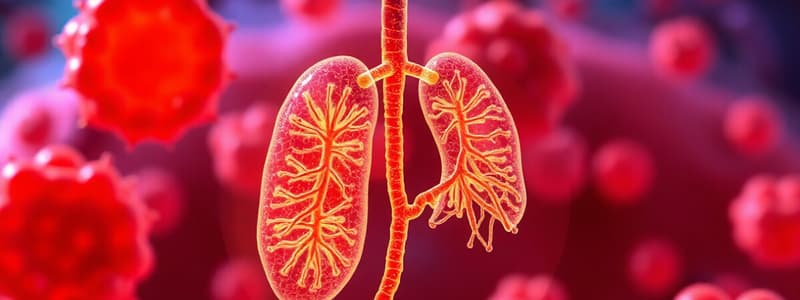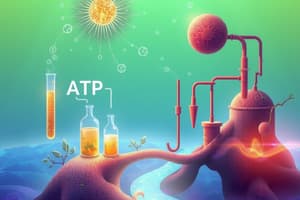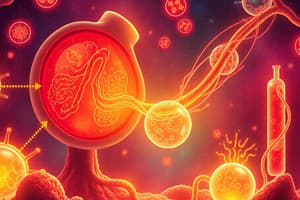Podcast
Questions and Answers
During cellular respiration, NADH is utilized in oxidative phosphorylation. What is the direct outcome of this process?
During cellular respiration, NADH is utilized in oxidative phosphorylation. What is the direct outcome of this process?
- The breakdown of ethanol into carbon dioxide and water.
- Regeneration of NAD+ without ATP production.
- The synthesis of 3 ATPs per NADH. (correct)
- The production of lactic acid.
Which of the following is a key difference in the location of fermentation and respiration within a cell?
Which of the following is a key difference in the location of fermentation and respiration within a cell?
- Fermentation occurs in the mitochondria only, while respiration occurs in the cytoplasm only.
- Both fermentation and respiration occur exclusively in the mitochondria.
- Both fermentation and respiration occur exclusively in the cytoplasm.
- Fermentation occurs in the cytoplasm, while respiration occurs in both the cytoplasm and mitochondria. (correct)
In what way does the role of oxygen differ between fermentation and cellular respiration?
In what way does the role of oxygen differ between fermentation and cellular respiration?
- Oxygen is not obligatory for fermentation, but it is mandatory for respiration. (correct)
- Oxygen is not involved in either fermentation or cellular respiration.
- Oxygen is mandatory for fermentation, but it is not obligatory for respiration.
- Oxygen is mandatory for both fermentation and cellular respiration.
What is the primary reason cellular respiration produces significantly more ATP than fermentation?
What is the primary reason cellular respiration produces significantly more ATP than fermentation?
Both fermentation and cellular respiration begin with the breakdown of glucose. What intermediate compound is common to both of these processes?
Both fermentation and cellular respiration begin with the breakdown of glucose. What intermediate compound is common to both of these processes?
During cellular respiration, which of the following events occurs in the cytoplasm?
During cellular respiration, which of the following events occurs in the cytoplasm?
What is the net ATP production during fermentation?
What is the net ATP production during fermentation?
In the absence of oxygen, what process do animal muscle cells utilize to generate ATP?
In the absence of oxygen, what process do animal muscle cells utilize to generate ATP?
Which of the following is NOT a product of the citric acid cycle?
Which of the following is NOT a product of the citric acid cycle?
Which of the following statements accurately describes the role of NADH and FADH2 in cellular respiration?
Which of the following statements accurately describes the role of NADH and FADH2 in cellular respiration?
How does inorganic phosphate affect sugar breakdown in cellular respiration and fermentation?
How does inorganic phosphate affect sugar breakdown in cellular respiration and fermentation?
In ethanol fermentation, what molecule is produced when pyruvate is decarboxylated?
In ethanol fermentation, what molecule is produced when pyruvate is decarboxylated?
Which process is common to both lactic acid and ethanol fermentation?
Which process is common to both lactic acid and ethanol fermentation?
Which of the following best describes the role of oxygen in aerobic cellular respiration?
Which of the following best describes the role of oxygen in aerobic cellular respiration?
Which of the following describes organisms that can survive in the absence of oxygen as they use fermentation to synthesize ATP?
Which of the following describes organisms that can survive in the absence of oxygen as they use fermentation to synthesize ATP?
Flashcards
Fermentation
Fermentation
The chemical breakdown of glucose by microorganisms, releasing heat and effervescence.
Cellular Respiration
Cellular Respiration
A group of chemical reactions that produce energy by oxidizing food, releasing water and carbon dioxide.
ATP Yield
ATP Yield
Fermentation produces 2 ATPs while respiration synthesizes 36 ATPs
Final Electron Acceptor
Final Electron Acceptor
Signup and view all the flashcards
Initial Step
Initial Step
Signup and view all the flashcards
Glycolysis
Glycolysis
Signup and view all the flashcards
Citric Acid Cycle
Citric Acid Cycle
Signup and view all the flashcards
Oxidative Phosphorylation
Oxidative Phosphorylation
Signup and view all the flashcards
Aerobic Respiration
Aerobic Respiration
Signup and view all the flashcards
Anaerobic Respiration
Anaerobic Respiration
Signup and view all the flashcards
Lactic Acid Fermentation
Lactic Acid Fermentation
Signup and view all the flashcards
Ethanol Fermentation
Ethanol Fermentation
Signup and view all the flashcards
Autotrophs
Autotrophs
Signup and view all the flashcards
Study Notes
- Fermentation and cellular respiration are metabolic processes that break down glucose to produce energy in the form of ATP.
Key Differences
- In fermentation, NADH does not undergo oxidative phosphorylation to synthesize ATP.
- In respiration, NADH is utilized in oxidative phosphorylation, synthesizing 3 ATPs per NADH.
- Fermentation is the chemical breakdown of glucose by microorganisms, releasing heat and effervescence.
- Respiration involves chemical reactions that oxidize food to produce energy, releasing water and carbon dioxide.
- Fermentation doesn't require oxygen, while respiration mandates it.
- Water is a byproduct of respiration, but not fermentation.
- Fermentation occurs in the cytoplasm, while respiration occurs in both the cytoplasm and mitochondria.
- Fermentation synthesizes only 2 ATPs, whereas respiration synthesizes 36 ATPs.
- The substrate is not entirely broken down in fermentation, but it is entirely broken down in respiration.
- Ethanol and lactic acid fermentations are fermentation types, while aerobic and anaerobic respiration are respiration types.
- The final electron acceptor is an organic molecule in fermentation, and oxygen in respiration.
- Regeneration of NAD+ in fermentation does not involve ATP production, while it synthesizes three ATPs in respiration.
- Fermentation usually occurs in microorganisms; respiration is found in higher organisms.
Similarities
- Both cellular respiration and fermentation start with the breakdown of glucose into pyruvate.
- Hexoses are substrates in both processes.
- Pyruvate is an intermediate compound in both processes.
- Inorganic phosphate increases the rate of sugar breakdown in both processes.
Cellular Respiration
- Respiration is a group of chemical reactions associated with energy production through complete food oxidation.
- Animals use mitochondrion during respiration
- It releases water and carbon dioxide.
- It produces 36 ATPs and occurs in the mitochondria and cytoplasm.
- It occurs in three steps: glycolysis, the citric acid cycle, and the electron transport chain.
- Glycolysis occurs in the cytoplasm, where two pyruvate molecules are synthesized.
- Pyruvate molecules are transported to the mitochondrial matrix.
- Each molecule releases a carbon dioxide molecule and transforms into acetyl CoA through oxidative decarboxylation.
- Acetyl-CoA enters the citric acid cycle, oxidizing a glucose molecule into 6 carbon dioxide molecules, creating 2 GTPs, 6 NADH, and 2FADH2.
- Oxidative phosphorylation creates ATP when NADH and FADH2 combine with oxygen in the inner mitochondrial membrane.
- Electrons are transported through a group of electron carriers from NADH and FADH2 in the electron transport chain.
- The cellular respiration equation is C6H12O6 +6O2 —› 6CO2 + 6H2O +ATP.
- Aerobic respiration occurs in the presence of oxygen.
- Anaerobic respiration occurs in the absence or limited availability of oxygen.
- Photoautotrophs depend on cellular respiration when photosynthesis cannot be conducted.
- Chemoautotrophs transform inorganic molecules into energy under extreme conditions, like the absence of sunlight and oxygen.
- Heterotrophs eat autotrophs and convert stored biomass into energy through cellular respiration.
Fermentation
- Fermentation involves the chemical processing of organic substrates like glucose by microorganisms, releasing heat and effervescence.
- It occurs in the cytoplasmic region of cells, yielding a net result of 2 ATPs.
- It comprises two steps: glycolysis and partial oxidization of pyruvate.
- After glycolysis, pyruvate acts as the electron acceptor in lactic acid fermentation, and acetaldehyde in ethanol fermentation.
- Ethanol fermentation occurs in yeast without oxygen.
- Lactic acid fermentation takes place in bacteria; in animals, it occurs in muscles without oxygen.
- Glycolysis is the same for both processes, breaking down pyruvate into two pyruvate molecules and synthesizing 2 ATPs.
- During glycolysis, 2 molecules of NADH are formed by taking electrons from glyceraldehyde-3-phosphate.
- In ethanol fermentation, pyruvate is decarboxylated to acetaldehyde, releasing carbon dioxide, and acetaldehyde converts into ethanol.
- In lactic acid fermentation, pyruvate is converted into lactic acid, then oxidized back to lactate.
Types of Fermentation
- C6H12O6 —› 2C2H5OH + 2CO2 + 2ATP is the chemical equation for ethanol fermentation.
- C6H12O6 —› 2C3H6O3 + 2ATP is the chemical equation for lactic acid fermentation.
Examples of Fermentation
- The human body uses fermentation for energy when oxygen is insufficient, such as during strenuous exercise.
- Lactic acid fermentation occurs in muscle cells to produce energy when oxygen supply is limited.
- Fermentation is an alternative pathway for ATP production, especially in obligate anaerobes.
- Neocallimastix fungi digest cellulose through fermentation in herbivorous animals.
- Bacteroides bacteria degrade sugar derivatives from plants in the human colon through fermentation.
- Facultative anaerobes like Saccharomyces cerevisiae and Saccharomyces pombe ferment even in the presence of oxygen.
- Kluyveromyces lactis yeast carries out more respiration than fermentation if oxygen is present.
- Lactic acid fermentation by fungi and bacteria is used to synthesize yogurt and cheese.
- Alcohol fermentation by yeast is used to synthesize liquor and wine.
Studying That Suits You
Use AI to generate personalized quizzes and flashcards to suit your learning preferences.




